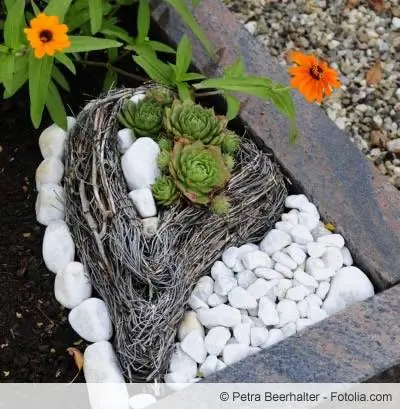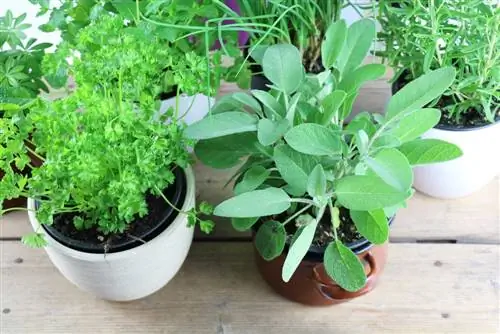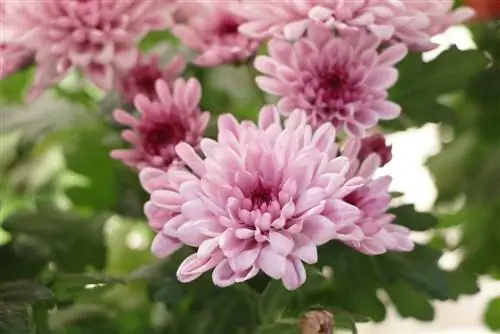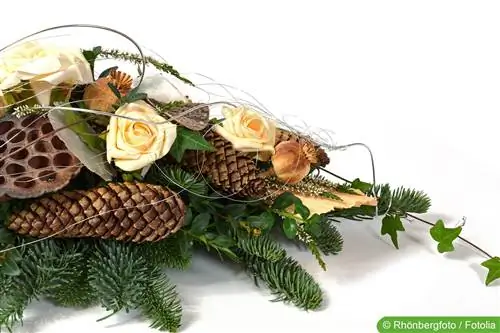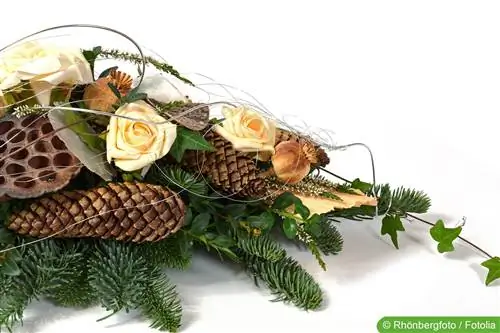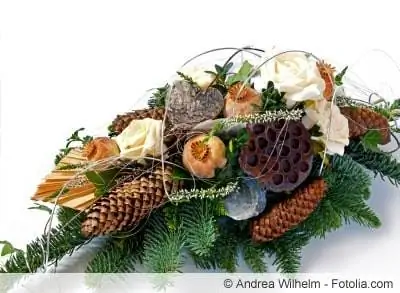- Author admin [email protected].
- Public 2023-12-17 03:39.
- Last modified 2025-01-24 12:45.
By arranging a grave on their own, the bereaved enter into an active phase of mourning. Stones come into focus as sacred symbols of eternity. While the gravestone manifests the permanent appearance of a resting place, the design of the grave area underlines the individual appearance over the course of the seasons. Gravel and stones also fulfill prosaic functions by making an important contribution to undemanding maintenance. Dive into creative ideas here that may serve as inspiration for making your own grave decoration.
Selection of stones according to their symbolic character
If you look at it soberly, a grave area is no different from a garden bed. If you want to decorate with gravel and stones, you should basically follow the same requirements as those for a classic gravel bed. In order to include the spiritual character of a resting place in the design, the metaphorical meaning should be included as a selection criterion in addition to the aesthetics. In the following overview of recommended types of stone, the respective symbolic character is added:
- Agate: the protective stone for the living and the dead
- Aventurine (variety of quartz): demonstrates hope and optimism
- Rock crystal, clear (variety of quartz): symbol of the harmonious alignment to a higher self
- Carrara marble: simple elegance, testifies to exquisite taste
- Dolomite: provides emotional stability
- Iron pebble (variety of quartz): symbolizes energy and courage
- Granite: embodies strength and energy
- Rose quartz: healing stone for the tormented heart
These types of ornamental gravel are all particularly valuable types of stone, some of which are precious and semi-precious stones. Considering the small area that is decorated with it, the purchase price is kept within manageable limits. Aventurine is available for 3.95 euros per kilogram or rose quartz for 4.30 euros, each plus shipping costs.
Ideas for flat grave design
As long as it does not contradict the current cemetery regulations, covering the entire grave area with gravel or stones is considered the easiest option to maintain. However, in this case a certain degree of creativity is required so that a stereotypical look is not created. The following ideas aim to create small islands of geometric shapes. Inserted reliefs in the form of boulders, statues or planted bowls reflect the vicissitudes of life with its eternal ups and downs.
- Form circles, ovals, diamonds, pyramids or rectangles out of stones
- Fill these with smaller-grained stones, gravel or grit in a different color shade
- Alternatively, place a regional boulder in the stone frame
- You can optionally first create small embankments of earth that are decorated with gravel or grit

A grave area uniformly covered with white or gray marble gravel looks like a clean slate, but at the same time a little monotonous. You can set accents here with a planted bowl and matching grave lantern. Stone ornaments, such as the open book with an inserted picture of the deceased, create an individual frame.
Tip:
The final decoration of a grave with stones should not begin until 6 months after the burial at the earliest. Until then, the loosened earth will sink repeatedly and would destroy any efforts at creative design.
Composition of stones and plants
The large-scale design of a resting place with stones is primarily recommended if relatives can only rarely visit the cemetery. Ideally, the time frame allows relatives to combine evergreen and flowering plants with stones and gravel to enrich the visual aura of a resting place with liveliness. As long as the temperature and weather conditions as well as the soil conditions at the location allow it, the symbolic character of the plants once again becomes the focus of the search for ideas. This gives mourners a unique opportunity to create grave decorations in such a way that they echo the melody of a fulfilling life. The following overview introduces traditional plants:
- Lily: symbolizes the purity of the Mother of God
- Forget-me-not: demonstrates tender memories
- bleeding heart: symbolizes deep sadness
- Memorial: Symbol of eternal loy alty
- Chrysanthemums: as a sign of immortality
- Bedding rose: symbol of eternal love
- Houseleek
- Juniper
- Boxwood
- Wormuth
If a grave is decorated with symbolic plants and spiritually influenced types of stone, the viewer senses that the relatives have made an effort that goes far beyond functionality. The well-groomed appearance is emotionally enhanced with the memory of the deceased, whose philosophy of life is symbolized in a dignified setting.
Suggestions for grave decorations with stones and plants
With the use of stones and gravel, a modern component found its way into the decoration of resting places. These include asymmetrical shapes, such as those evident in the design of gravestones. The unstoppable change of time is also expressed in the cemetery. So that the comforting effect of symbolism and mythology is not lost, the following suggestions advocate their preservation by focusing on the use of local plants.
- A flat grave covering made of ornamental gravel is framed by a boxwood hedge
- The stone type of the border is repeated in small stone islands, with the spaces in between filled with ground cover plants
- Evergreen, native species such as ivy or medlar preserve the tradition
- Deep black grave soil provides an eye-catching contrast to stones, gravel and plants
- Wave-shaped rails create sectors, variously filled with decorative gravel and planted grave soil
- Stone statues, grave vases or lanterns serve as a visual haven of calm
- A stone-filled, heart-shaped gabion forms the center, planted with the moss of the forest
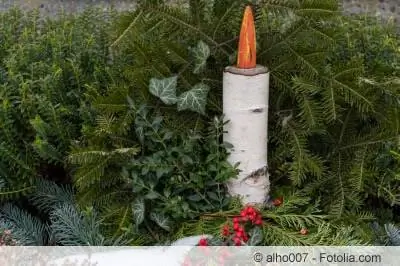
Measure the relationship between the stone area and the planted area according to the time available for maintenance work. Even in small bed areas, you can achieve a special naturalness with the help of seasonal changes in the planting. In spring, daffodils, pansies and tulips join the granite and rose quartz. In summer, geraniums, daisies and forget-me-nots take over. Autumn is the time for chrysanthemums and heather, followed by hardy houseleeks. When choosing a plant, consider the memory of the deceased. If a special floral scent manifests itself as an anchor for memories, this plant should be taken into account in the planting plan.
Tip:
The currently valid cemetery statutes should be studied in detail in advance, as there are regionally different regulations for grave decoration.
Decorate urn grave
Decorating an urn grave is a particular challenge due to the narrow dimensions of 1 m x 1 m. If the decision is made against a continuous stone slab, a special quality of creativity is required. The following ideas may serve as inspiration:
- One corner is decorated with decorative gravel, the other is covered with grave soil and planted
- Alternatively, a planted bowl is placed on the decorative gravel and a memorial plate is laid out on the ground
- More than two different colored sectors clutter up the small area
- Small, native wild perennials create authenticity, such as the meadow bellflower, mountain aster or centaury
A stone surround visually overwhelms an urn grave. In contrast, a frame made of small hedge myrtle loosens up the appearance.
Tips for practical implementation
So that the imaginative ideas for the design concept take the desired form, the following practical tips should be taken to heart:
- Do not begin work until the earth has completely settled
- Dig the soil 20-25 centimeters deep to remove weeds, stones and roots
- If planting is planned, the soil is dug up and enriched with humus
- Place rubber or metal guide rails into the ground to limit the sectors
- Spread stable weed fleece
- Cut the fleece in a cross shape at the positions of the plants
- In the last step, distribute gravel or stones
Conclusion
The inclusion of gravel and stones in the design of a resting place goes beyond pure aesthetics when the sacred and spiritual symbolism of individual types of stone is consciously taken into account. At the same time, a cover made of decorative gravel keeps weeds in check, so that the maintenance effort is noticeably reduced. The search for ideas thus becomes an active work of mourning, which results in a grave decoration that expresses the fulfilled life of the deceased. This is especially true when an individual composition is created from stones, gravel and plants.

